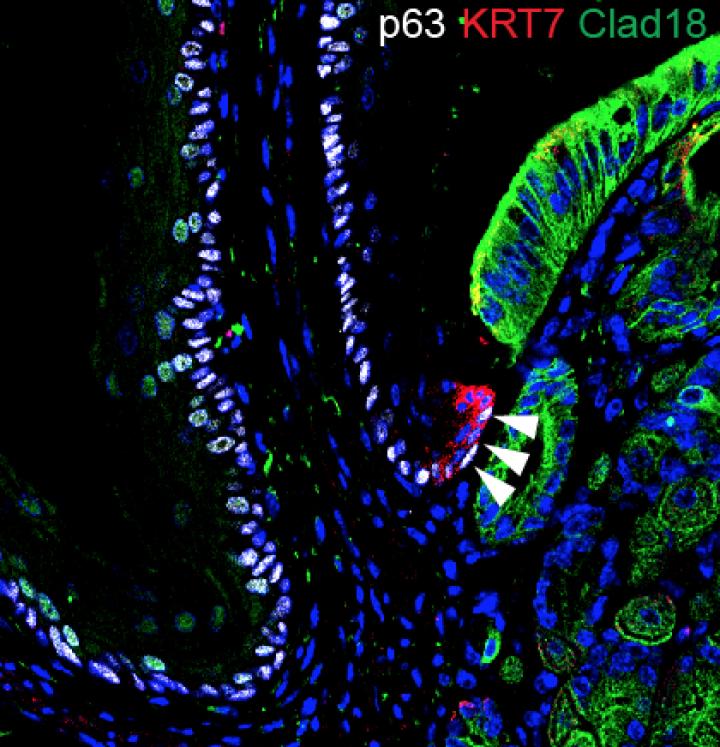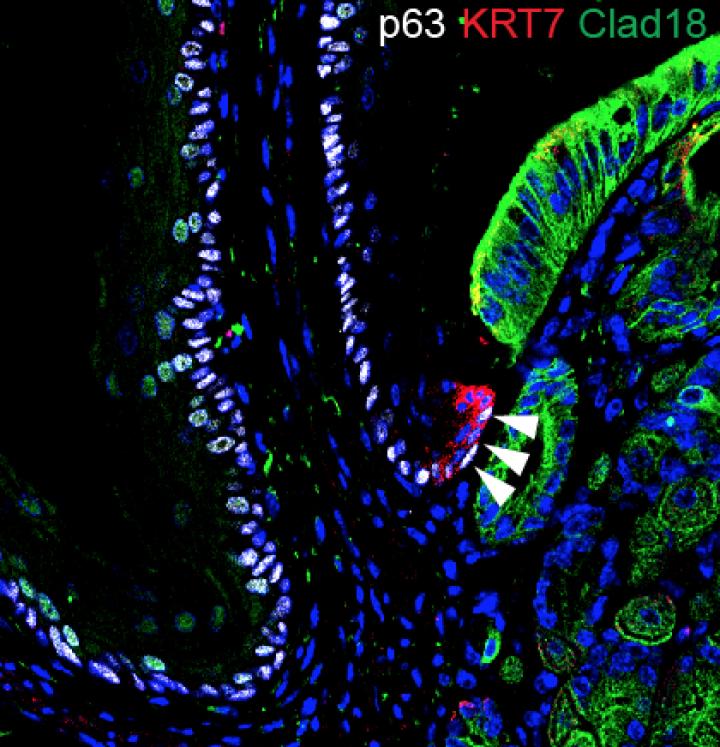
Credit: Lab of Jianwen Que, MD, PhD, Columbia University Medical Center
NEW YORK, NY (October 11, 2017)–Columbia University Medical Center (CUMC) researchers have identified cells in the upper digestive tract that can give rise to Barrett's esophagus, a precursor to esophageal cancer. The discovery of this "cell of origin" promises to accelerate the development of more precise screening tools and therapies for Barrett's esophagus and esophageal adenocarcinoma, the fastest growing form of cancer in the U.S.
The findings, made in mice and in human tissue, were published in today's online edition of Nature.
In Barrett's esophagus, some of the tissue in the tube connecting the mouth to the stomach are replaced by intestinal-like tissue, causing heartburn and difficulty swallowing. Most cases of Barrett's stem from gastroesophageal reflux disease (GERD)–chronic regurgitation of acid from the stomach into the lower esophagus. A small percentage of people with Barrett's esophagus develop esophageal adenocarcinoma, the most common form of esophageal cancer.
Incidence of esophageal adenocarcinoma has risen by 800 percent over the past four decades. However, there has been little progress in screening and treatment over the same period. If esophageal cancer is not detected early, patients typically survive less than a year after diagnosis.
Researchers have proposed at least five models of Barrett's esophagus, each based on a different cell type. "However, none of these experimental models mimics all of the characteristics of the condition," said study leader Jianwen Que, MD, PhD, associate professor of medicine at CUMC. "This led us to believe that there must be another, yet-to-be-discovered, cell of origin for Barrett's esophagus."
In the current study, Dr. Que and his colleague Ming Jiang, PhD, an associate research scientist in CUMC's Department of Medicine and first author of the paper, genetically altered mice to promote the development of Barrett's esophagus. His team then examined the mice's gastroesophageal junction tissue for changes. "All of the known cells in this tissue remained the same, but we found a previously unidentified zone populated by unique basal progenitor cells," he said. Progenitor cells are early descendants of stem cells that can differentiate into one or more specific cell types.
Dr. Que's team then performed a technique called lineage tracing to determine if these unique basal progenitor cells, tagged with a fluorescent protein, can give rise to Barrett's esophagus. In the tests, several mouse models were used to show that bile acid reflux or genetic changes promote expansion of these cells, leading to the development of Barrett's esophagus. The same observations were made in organoids (artificially grown masses of cells that resemble an organ) created from unique basal progenitor cells that were isolated from the gastroesophageal junction in mice and humans.
"Now that we know the cell of origin for Barrett's esophagus, the next step is to develop therapies that target these cells or the signaling pathways that are activated by acid reflux," said Dr. Que.
###
The study is titled, "Transitional basal cells at the squamous-columnar junction generate Barrett's oesophagus." The other contributors are: Haiyan Li (Columbia University Medical Center, New York, NY), Yongchun Zhang (CUMC), Ying Yang (CUMC), Rong Lu (CUMC), Kuancan Liu (CUMC and Fuzhou General Hospital, Fuzhou, Fujian, China), Sijie Lin (CUMC and Fuzhou General Hospital), Xiaopeng Lan (Fuzhou General Hospital), Haikun Wang (Chinese Academy of Sciences, Shanghaim, China), Han Wu (Ascendas Genomics Inc., Zhongshan, Guandong, China), Jian Zhu (University of Rochester, Rochester, NY), Zhongren Zhou (University of Rochester), Jianming Xu (Baylor College of Medicine, Houston, TX), Dong-Kee Lee (Baylor College of Medicine), Lanjing Zhang (University Medical Center of Princeton at Plainsboro, Plainsboro, NJ, and Rutgers University, Newark, NJ), Yuan-Cho Lee (CUMC), Jingsong Yuan (CUMC), Julian A. Abrams (CUMC), Timothy G. Wang (CUMC), Antonia R. Sepulveda (CUMC), Qi Wu (Tianjin Haihe Hospital, Tianjin. China), Huaiyong Chen (Tianjin Haihe Hospital), Xin Sun (Tianjin Haihe Hospital), Junjun She (Xi'an Jiaotong University, Xi'an, China), and Xiaoxin Chen (North Carolina Central University, Durham, NC).
The study was supported by grants from the National Institutes of Health (R01DK113144, R01DK100342, R01HL132996, R01CA112403, and R01CA193455), March of Dimes, Price Family Foundation, the National Key Research and Development Program of China, National Natural Science Foundation of China, the Program for the Top Young Innovative Talents of Fujian Province, and the International Collaborative Project of Fujian Province.
The authors report no financial or other conflicts of interest.
Columbia University Medical Center provides international leadership in basic, preclinical, and clinical research; medical and health sciences education; and patient care. The medical center trains future leaders and includes the dedicated work of many physicians, scientists, public health professionals, dentists, and nurses at the College of Physicians and Surgeons, the Mailman School of Public Health, the College of Dental Medicine, the School of Nursing, the biomedical departments of the Graduate School of Arts and Sciences, and allied research centers and institutions. Columbia University Medical Center is home to the largest medical research enterprise in New York City and State and one of the largest faculty medical practices in the Northeast. The campus that Columbia University Medical Center shares with its hospital partner, NewYork-Presbyterian, is now called the Columbia University Irving Medical Center. For more information, visit cumc.columbia.edu or columbiadoctors.org.
Media Contact
Helen Garey
[email protected]
917-514-1317
@ColumbiaMed
http://www.cumc.columbia.edu
Related Journal Article
http://dx.doi.org/10.1038/nature24269





